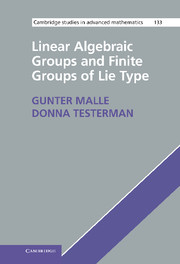Book contents
- Frontmatter
- Contents
- Preface
- List of tables
- Notation
- PART I LINEAR ALGEBRAIC GROUPS
- PART II SUBGROUP STRUCTURE AND REPRESENTATION THEORY OF SEMISIMPLE ALGEBRAIC GROUPS
- PART III FINITE GROUPS OF LIE TYPE
- Appendix A Root systems
- Appendix B Subsystems
- Appendix C Automorphisms of root systems
- References
- Index
PART II - SUBGROUP STRUCTURE AND REPRESENTATION THEORY OF SEMISIMPLE ALGEBRAIC GROUPS
Published online by Cambridge University Press: 05 June 2012
- Frontmatter
- Contents
- Preface
- List of tables
- Notation
- PART I LINEAR ALGEBRAIC GROUPS
- PART II SUBGROUP STRUCTURE AND REPRESENTATION THEORY OF SEMISIMPLE ALGEBRAIC GROUPS
- PART III FINITE GROUPS OF LIE TYPE
- Appendix A Root systems
- Appendix B Subsystems
- Appendix C Automorphisms of root systems
- References
- Index
Summary
In this part we develop the basic structure and representation theory of semisimple and more generally of reductive algebraic groups. The aim of this part is twofold. First, we want to provide sufficient information in order to be able to formulate the classification results on maximal subgroups of simple algebraic groups presented in Chapters 18 and 19 and to sketch the important ingredients in their proof. Secondly, we prepare the notions and results necessary for the investigation of the finite groups of Lie type in Part III.
It has already been indicated in Chapter 8 that the structure and classification of reductive groups is somehow controlled by their maximal connected solvable subgroups, the Borel subgroups. This will become even more apparent here. The crucial starting point, on which most of the development in this part will be based, is the structure result for Borel subgroups of reductive groups in Theorem 11.1. From this, we first derive the so-called Bruhat decomposition, which is of a more topological nature, and then also the more combinatorial BN-pair structure of connected reductive groups. The latter leads to the notion of parabolic subgroups and their Levi decomposition, which are studied in Chapter 12. In the framework of classical groups, parabolic subgroups arise very naturally as the stabilizers of isotropic subspaces in the natural matrix representation.
Chapter 13 is devoted to the study of subsystem subgroups, that is, subgroups normalized by a maximal torus. These comprise the Levi subgroups already encountered before, but also the centralizers of semisimple elements.
- Type
- Chapter
- Information
- Linear Algebraic Groups and Finite Groups of Lie Type , pp. 81 - 82Publisher: Cambridge University PressPrint publication year: 2011



